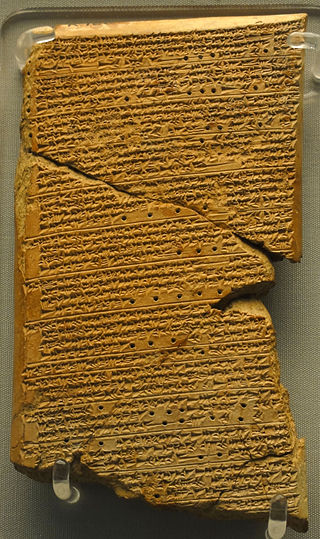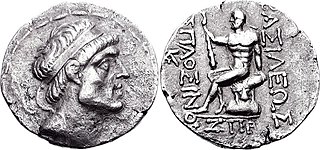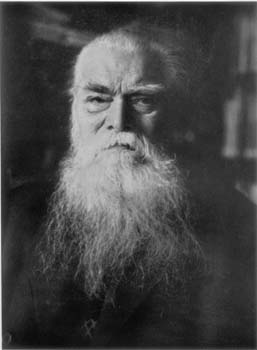Otto Eduard Neugebauer was an Austrian-American mathematician and historian of science who became known for his research on the history of astronomy and the other exact sciences as they were practiced in antiquity and the Middle Ages. By studying clay tablets, he discovered that the ancient Babylonians knew much more about mathematics and astronomy than had been previously realized. The National Academy of Sciences has called Neugebauer "the most original and productive scholar of the history of the exact sciences, perhaps of the history of science, of our age."

The Venus tablet of Ammisaduqa is the record of astronomical positions for Venus, as preserved in numerous cuneiform tablets dating from the first millennium BC. It is believed that this astronomical record was first compiled during the reign of King Ammisaduqa, the fourth ruler after Hammurabi. Thus, the origins of this text could probably be dated to around the mid-seventeenth century BC despite allowing two possible dates.
Ladislav Zgusta was a Czech-American historical linguist and lexicographer, who wrote one of the first textbooks on lexicography. He was a professor of linguistics and classics at the University of Illinois at Urbana-Champaign. Dutch lexicographer Piet van Sterkenburg referred to Zgusta as "the twentieth-century godfather of lexicography". He was elected a Fellow of the American Academy of Arts and Sciences in 1992, and in the same year awarded the Gold Medal of the Czech Academy of Sciences for his work in Humanities.

Babylonian astronomy was the study or recording of celestial objects during the early history of Mesopotamia.
David Edwin Pingree was an American historian of mathematics in the ancient world. He was a University Professor and Professor of History of Mathematics and Classics at Brown University.

MUL.APIN is the conventional title given to a Babylonian compendium that deals with many diverse aspects of Babylonian astronomy and astrology. It is in the tradition of earlier star catalogues, the so-called Three Stars Each lists, but represents an expanded version based on more accurate observation, likely compiled around 1000 BCE. The text lists the names of 66 stars and constellations and further gives a number of indications, such as rising, setting and culmination dates, that help to map out the basic structure of the Babylonian star map.

The Austrian Academy of Sciences is a legal entity under the special protection of the Republic of Austria. According to the statutes of the Academy its mission is to promote the sciences and humanities in every respect and in every field, particularly in fundamental research.
Agum III was a Kassite king of Babylon ca. mid-15th century BC. Speculatively, he might figure around the 13th position in the dynastic sequence; however, this part of the Kingslist A has a lacuna, shared with the Assyrian Synchronistic Kinglist.
T. J. F. (Tom) Tillemans is a Dutch-Canadian Buddhologist, Indologist and Tibetologist. Since 1992, Tillemans has been Professor of Buddhology in the Faculty of Oriental Languages and Civilizations at the University of Lausanne in Switzerland.
Hermann Junker was a German archaeologist best known for his discovery of the Merimde-Benisalam site in the West Nile Delta in Lower Egypt in 1928.
Abraham (Abe) Sachs was an American Assyriologist. He earned his PhD in Assyriology in 1939 at Johns Hopkins University.
Theophilus Goldridge Pinches M.R.A.S., was a pioneer British assyriologist.

Hyspaosines was an Iranian prince, and the founder of Characene, a kingdom situated in southern Mesopotamia. He was originally a Seleucid satrap installed by king Antiochus IV Epiphanes, but declared independence in 141 BC after the collapse and subsequent transfer of Seleucid authority in Iran and Babylonia to the Parthians. Hyspaosines briefly occupied the Parthian city of Babylon in 127 BC, where he is recorded in records as king (šarru). In 124 BC, however, he was forced to acknowledge Parthian suzerainty. He died in the same year, and was succeeded by his juvenile son Apodakos.
Johann Jakob Hess, was a Swiss Egyptologist and Assyriologist and an expert in other Oriental languages.

The Babylonian astronomical diaries are a collection of Babylonian cuneiform texts that contain systematic records of astronomical observations and political events as well as predictions, based on astronomical observations. They also include other information such as commodity prices for particular dates and weather reports.
Hermann von Wissmann was a German-Austrian explorer of Arabia.
Tycho Quirinus Mrsich was a German scholar of Ancient Egyptian law.

Dietrich Ritter Kralik von Meyrswalden was an Austrian philologist who specialized in Germanic studies.

Karl Konrad Ferdinand Maria von Amira was a German jurist who served as Professor of Constitutional Law at the Ludwig Maximilian University of Munich. He was a known expert on early Germanic law.
Erragal or Errakal was a Mesopotamian god presumed to be related to Erra. However, there is no agreement about the nature of the connection between them in Assyriology. While Erragal might have been associated with storms and the destruction caused by them, he is chiefly attested as a benevolent deity, for example as an astral god with apotropaic functions. He was regarded as the husband of the goddess Ninšar, the divine butcher of Ekur, and they could be represented as a pair of stars in astronomical treatises such as MUL.APIN. References to worship of Erragal are uncommon, though he nonetheless appears in a variety of sources from the Isin-Larsa period to Neo-Babylonian times. He also appears in the Epic of Gilgamesh and in Atra-Hasis as a deity linked to the great flood.








